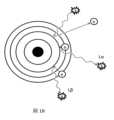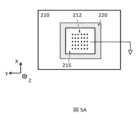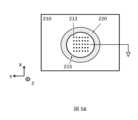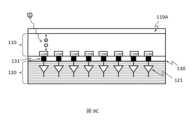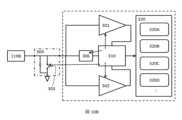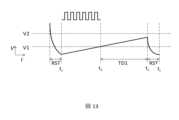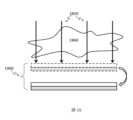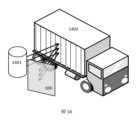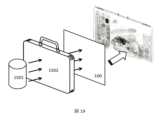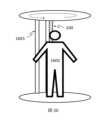TWI788362B - An integrated x-ray source, system and element analyzer comprising x-ray source - Google Patents
An integrated x-ray source, system and element analyzer comprising x-ray sourceDownload PDFInfo
- Publication number
- TWI788362B TWI788362BTW107119243ATW107119243ATWI788362BTW I788362 BTWI788362 BTW I788362BTW 107119243 ATW107119243 ATW 107119243ATW 107119243 ATW107119243 ATW 107119243ATW I788362 BTWI788362 BTW I788362B
- Authority
- TW
- Taiwan
- Prior art keywords
- ray
- ray source
- detector
- patent application
- voltage
- Prior art date
Links
Images
Classifications
- G—PHYSICS
- G01—MEASURING; TESTING
- G01V—GEOPHYSICS; GRAVITATIONAL MEASUREMENTS; DETECTING MASSES OR OBJECTS; TAGS
- G01V5/00—Prospecting or detecting by the use of ionising radiation, e.g. of natural or induced radioactivity
- G01V5/20—Detecting prohibited goods, e.g. weapons, explosives, hazardous substances, contraband or smuggled objects
- H—ELECTRICITY
- H01—ELECTRIC ELEMENTS
- H01J—ELECTRIC DISCHARGE TUBES OR DISCHARGE LAMPS
- H01J35/00—X-ray tubes
- H01J35/02—Details
- H01J35/04—Electrodes ; Mutual position thereof; Constructional adaptations therefor
- H01J35/06—Cathodes
- H01J35/065—Field emission, photo emission or secondary emission cathodes
- A—HUMAN NECESSITIES
- A61—MEDICAL OR VETERINARY SCIENCE; HYGIENE
- A61B—DIAGNOSIS; SURGERY; IDENTIFICATION
- A61B6/00—Apparatus or devices for radiation diagnosis; Apparatus or devices for radiation diagnosis combined with radiation therapy equipment
- A61B6/40—Arrangements for generating radiation specially adapted for radiation diagnosis
- A61B6/4007—Arrangements for generating radiation specially adapted for radiation diagnosis characterised by using a plurality of source units
- H—ELECTRICITY
- H01—ELECTRIC ELEMENTS
- H01J—ELECTRIC DISCHARGE TUBES OR DISCHARGE LAMPS
- H01J35/00—X-ray tubes
- H01J35/02—Details
- H01J35/04—Electrodes ; Mutual position thereof; Constructional adaptations therefor
- H01J35/045—Electrodes for controlling the current of the cathode ray, e.g. control grids
- H—ELECTRICITY
- H01—ELECTRIC ELEMENTS
- H01J—ELECTRIC DISCHARGE TUBES OR DISCHARGE LAMPS
- H01J35/00—X-ray tubes
- H01J35/02—Details
- H01J35/04—Electrodes ; Mutual position thereof; Constructional adaptations therefor
- H01J35/08—Anodes; Anti cathodes
- H01J35/112—Non-rotating anodes
- H01J35/116—Transmissive anodes
- H—ELECTRICITY
- H05—ELECTRIC TECHNIQUES NOT OTHERWISE PROVIDED FOR
- H05G—X-RAY TECHNIQUE
- H05G1/00—X-ray apparatus involving X-ray tubes; Circuits therefor
- H05G1/02—Constructional details
- A—HUMAN NECESSITIES
- A61—MEDICAL OR VETERINARY SCIENCE; HYGIENE
- A61B—DIAGNOSIS; SURGERY; IDENTIFICATION
- A61B6/00—Apparatus or devices for radiation diagnosis; Apparatus or devices for radiation diagnosis combined with radiation therapy equipment
- A61B6/02—Arrangements for diagnosis sequentially in different planes; Stereoscopic radiation diagnosis
- A61B6/03—Computed tomography [CT]
- A61B6/032—Transmission computed tomography [CT]
- H—ELECTRICITY
- H01—ELECTRIC ELEMENTS
- H01J—ELECTRIC DISCHARGE TUBES OR DISCHARGE LAMPS
- H01J2235/00—X-ray tubes
- H01J2235/02—Electrical arrangements
- H—ELECTRICITY
- H01—ELECTRIC ELEMENTS
- H01J—ELECTRIC DISCHARGE TUBES OR DISCHARGE LAMPS
- H01J2235/00—X-ray tubes
- H01J2235/06—Cathode assembly
- H01J2235/062—Cold cathodes
Landscapes
- Life Sciences & Earth Sciences (AREA)
- Health & Medical Sciences (AREA)
- Physics & Mathematics (AREA)
- Engineering & Computer Science (AREA)
- Medical Informatics (AREA)
- High Energy & Nuclear Physics (AREA)
- Heart & Thoracic Surgery (AREA)
- Animal Behavior & Ethology (AREA)
- Optics & Photonics (AREA)
- Pathology (AREA)
- Radiology & Medical Imaging (AREA)
- Biomedical Technology (AREA)
- Biophysics (AREA)
- Molecular Biology (AREA)
- Surgery (AREA)
- Nuclear Medicine, Radiotherapy & Molecular Imaging (AREA)
- General Health & Medical Sciences (AREA)
- Public Health (AREA)
- Veterinary Medicine (AREA)
- General Life Sciences & Earth Sciences (AREA)
- General Physics & Mathematics (AREA)
- Geophysics (AREA)
- Measurement Of Radiation (AREA)
- Pulmonology (AREA)
- Theoretical Computer Science (AREA)
- Analysing Materials By The Use Of Radiation (AREA)
Abstract
Translated fromChineseDescription
Translated fromChinese本發明涉及集成在芯片上的X射線源。The invention relates to an X-ray source integrated on a chip.
X射線螢光(XRF)是從諸如暴露於高能X射線或伽馬射線的材料激發出的特征螢光X射線。如果原子暴露於具有大於電子的電離勢的光子能量的X射線或伽馬射線,該原子內層軌道上的電子可被逐出,從而在內層軌道上留下空位。當原子外層軌道上的電子弛豫來填充內層軌道上的空位時,發射X射線(螢光X射線或二次X射線)。發射的X射線具有等於外層軌道與內層軌道電子之間的能差的光子能量。X-ray fluorescence (XRF) is the characteristic fluorescent X-ray excitation from materials such as those exposed to high-energy X-rays or gamma rays. If an atom is exposed to X-rays or gamma rays with photon energies greater than the ionization potential of electrons, electrons on the atom's inner orbitals can be ejected, leaving vacancies in the inner orbitals. X-rays (fluorescent X-rays or secondary X-rays) are emitted when electrons in the outer orbitals of the atom relax to fill vacancies in the inner orbitals. The emitted X-rays have photon energies equal to the energy difference between the outer orbit and inner orbit electrons.
對於給定原子,可能弛豫的數量受到限制。如在圖1A中示出的,當L軌道上的電子弛豫填充K軌道上的空位(L→K)時,螢光X射線叫作Kα。來自M→K弛豫的螢光X射線叫作Kβ。如在圖1B中示出的,來自M→L弛豫的螢光X射線叫作Lα,等等。For a given atom, the number of possible relaxations is limited. As shown in FIG. 1A , fluorescent X-rays are called Kα when electrons on the L orbital relax to fill the vacancy on the K orbital (L→K). Fluorescent X-rays from M→K relaxation are called Kβ. As shown in Figure IB, the fluorescent X-rays from the M→L relaxation are called Lα, and so on.
分析螢光X射線譜可以識別樣品中的元素,因為每個元素具有特征能量軌道。螢光X射線可以通過對光子能量分類(能量色散分析)或通過分離螢光X射線的波長(波長色散分析)來分析。每個特征能量峰的強度直接與樣品中的每個元素的含量有關。Analyzing the fluorescent X-ray spectrum can identify the elements in the sample because each element has characteristic energy orbitals. Fluorescent X-rays can be analyzed by sorting photon energies (energy dispersive analysis) or by separating the wavelengths of fluorescent X-rays (wavelength dispersive analysis). The intensity of each characteristic energy peak is directly related to the content of each element in the sample.
比例計數器或各種類型的固態檢測器(PIN二極體,Si(Li)、Ge(Li)、矽漂移檢測器SDD)可在能量色散分析中使用。這些檢測器基於相同原理:入射X射線光子使大量檢測器原子電離,其中產生的載荷子的數量與入射X射線光子的能量成比例。收集載荷子並且對它們計數來確定入射X射線光子的能量並且對下一個入射X射線光子重復該過程。在檢測到許多X射線光子後,可通過對X射線光子的數目(作為它們能量的函數)計數來編制光譜。因為由一個入射X射線光子產生的載荷子必須在下一個入射X射線光子撞擊檢測器之前被收集,這些檢測器的速度受到限制。Proportional counters or various types of solid state detectors (PIN diodes, Si(Li), Ge(Li), silicon drift detectors SDD) can be used in energy dispersive analysis. These detectors are based on the same principle: an incident X-ray photon ionizes a large number of detector atoms, where the number of charge carriers produced is proportional to the energy of the incident X-ray photon. The charge carriers are collected and counted to determine the energy of the incident X-ray photon and the process is repeated for the next incident X-ray photon. After detecting many X-ray photons,Spectra can be compiled by counting the number of X-ray photons as a function of their energy. These detectors are limited in speed because the charge carriers generated by one incident X-ray photon must be collected before the next incident X-ray photon hits the detector.
波長色散分析典型地使用光電倍增器。從入射X射線單色器選擇的單波長X射線光子被傳入光電倍增器。光電倍增器在單個X射線光子經過時對它們計數。計數器是包含可被X射線光子電離的氣體的腔。相對於導電腔壁,中心電極(典型地)充電+1700V,並且每個X射線光子觸發跨該場脈沖式級聯電流。該信號被放大並且變換成累積數字計數。這些計數用於確定在所選的單波長的X射線的強度。Wavelength dispersion analysis typically uses a photomultiplier. Single-wavelength X-ray photons selected from the incident X-ray monochromator are directed into a photomultiplier. A photomultiplier counts individual X-ray photons as they pass by. The counter is a cavity containing a gas that can be ionized by X-ray photons. The central electrode is charged (typically) +1700V with respect to the conducting chamber walls, and each X-ray photon triggers a pulsed cascade current across the field. This signal is amplified and converted into cumulative digital counts. These counts are used to determine the intensity of X-rays at a single wavelength of choice.
本發明公開X射線源,其包括:在第一襯底的凹部中的陰極;所述凹部的側壁上的對電極,被配置為使來自陰極電子的場發射;以及金屬陽極,其被配置為接收從所述陰極發射的電子並通過所述金屬陽極上的電子撞擊發射X射線。The present invention discloses an X-ray source comprising: a cathode in a recess of a first substrate; a counter electrode on a sidewall of said recess configured to cause field emission of electrons from the cathode; and a metal anode configured to Electrons emitted from the cathode are received and X-rays are emitted by electron impact on the metal anode.
根據實施例,所述陰極包括多個碳納米管。According to an embodiment, the cathode includes a plurality of carbon nanotubes.
根據實施例,所述對電極是圍繞所述側壁的連續環或點環。According to an embodiment, the counter electrode is a continuous ring or a point ring around the side wall.
根據實施例,所述X射線源還包括在所述對電極和所述金屬陽極之間的屏蔽電極,屏蔽電極被配置為排斥來自金屬陽極的電子。According to an embodiment, the X-ray source further comprises a shielding electrode between the counter electrode and the metal anode, the shielding electrode being configured to repel electrons from the metal anode.
根據實施例,所述屏蔽電極是圍繞所述側壁的連續環或點環。According to an embodiment, the shielding electrode is a continuous ring or a point ring around the side wall.
根據實施例,第一襯底包括矽或氧化矽。According to an embodiment, the first substrate includes silicon or silicon oxide.
根據實施例,金屬陽極包括一種或多種金屬,其選自包含鎢、鉬、錸、銅及其組合的組群。According to an embodiment, the metal anode includes one or more metals selected from the group consisting of tungsten, molybdenum, rhenium, copper, and combinations thereof.
根據實施例,所述X射線源還包括結合到第一襯底的第二襯底,其中所述第二襯底覆蓋所述凹部。According to an embodiment, the X-ray source further comprises a second substrate bonded to the first substrate, wherein the second substrate covers the recess.
根據實施例,金屬陽極由第二襯底支持。According to an embodiment, the metal anode is supported by the second substrate.
根據實施例,金屬陽極位於面對陰極的第二襯底的一側上。According to an embodiment, the metal anode is located on the side of the second substrate facing the cathode.
根據實施例,陰極包括碳納米管陣列。According to an embodiment, the cathode includes an array of carbon nanotubes.
本文公開包括下列各項的系統:多個上述X射線源中的任一個,多個X射線檢測器,其中X射線源和X射線檢測器交替設置;X射線屏蔽,其被配置為防止來自X射線源的X射線直接到達X射線檢測器。Disclosed herein is a system comprising: a plurality of any of the aforementioned X-ray sources, a plurality of X-ray detectors, wherein the X-ray sources and X-ray detectors are alternately arranged; an X-ray shield configured to prevent The X-rays from the source go directly to the X-ray detector.
根據實施例,X射線屏蔽是在X射線檢測器和X射線源之間的一層材料。According to an embodiment, the X-ray shield is a layer of material between the X-ray detector and the X-ray source.
根據實施例,所述材料層包括鎢(W)或鉛(Pb)。According to an embodiment, the material layer includes tungsten (W) or lead (Pb).
根據實施例,所述材料層的厚度為1.5-2mm。According to an embodiment, the material layer has a thickness of 1.5-2 mm.
本文公開包括任何上述X射線源和X射線檢測器的系統,其中,所述系統配置用於對人體胸部或腹部進行X射線照相。Disclosed herein is a system comprising any of the aforementioned X-ray sources and X-ray detectors, wherein the system is configured for X-raying a human chest or abdomen.
本文公開包括任何上述X射線源和X射線檢測器的系統,其中,所述系統配置用於對人的嘴巴進行X射線照相。Disclosed herein is a system comprising any of the aforementioned X-ray sources and X-ray detectors, wherein the system is configured for X-raying a mouth of a person.
本文公開貨物掃描或非侵入性檢查(NII)系統,其包括任何上述X射線源和X射線檢測器,其中,所述貨物掃描或非侵入性檢查系統被配置成基於背散射X射線形成圖像。Disclosed herein is a cargo scanning or non-invasive inspection (NII) system comprising any of the aforementioned X-ray sources and X-ray detectors, wherein the cargo scanning or non-invasive inspection system is configured to form an image based on backscattered X-rays .
本文公開貨物掃描或非侵入性檢查(NII)系統,其包括任何上述X射線源和X射線檢測器,其中,所述貨物掃描或非侵入性檢查(NII)系統被配置成基於通過穿過被檢查的物體的X射線形成圖像。Disclosed herein is a cargo scanning or non-invasive inspection (NII) system comprising any of the aforementioned X-ray sources and X-ray detectors, wherein the cargo scanning or non-invasive inspection (NII) system is configured to The X-rays of the object being examined form an image.
本文公開包括任何上述X射線源和X射線檢測器的全身掃描系統。A full body scanning system comprising any of the above described X-ray sources and X-ray detectors is disclosed herein.
本文公開X射線計算機斷層掃描(CT)系統,其包括任何上述X射線源和X射線檢測器。Disclosed herein is an X-ray computed tomography (CT) system comprising any of the aforementioned X-ray sources and X-ray detectors.
本文公開適於相襯X射線成像(PCI)的系統,所述系統包括任何上述X射線源和X射線檢測器。A system suitable for phase contrast x-ray imaging (PCI) comprising any of the aforementioned x-ray sources and x-ray detectors is disclosed herein.
本文公開包含任何上述X射線源的電子顯微鏡。Electron microscopes comprising any of the aforementioned X-ray sources are disclosed herein.
本文公開包括任何上述X射線源的輻射劑量計量儀。Radiation dosimeters comprising any of the aforementioned X-ray sources are disclosed herein.
本文公開包括任何上述X射線源1的元素分析儀。An elemental analyzer comprising any of the
本文公開適用於檢測X射線熒光(XRF)的系統,所述系統包括任何上述X射線源和X射線檢測器。A system suitable for detecting X-ray fluorescence (XRF) comprising any of the above-described X-ray sources and X-ray detectors is disclosed herein.
50:系統50: system
100:X射線檢測器100: X-ray detector
100A:全局計數器100A: Global counter
100B:全局計數器100B: Global counter
100C:全局計數器100C: Global counter
101:X射線檢測器101:X-ray detector
110:X射線吸收層110: X-ray absorbing layer
111:第一摻雜區111: the first doped region
112:本征區112: Intrinsic area
113:第二摻雜區113: the second doped region
114:離散區114: discrete area
119A:電觸點119A: electrical contact
119B:電觸點119B: electrical contact
120:電子層120: Electronic layer
121:電子系統121: Electronic system
130:填充材料130: filling material
131:通孔131: Through hole
150:圖元150: primitive
151:步驟151: Step
152:步驟152: Step
153A:倉153A: Warehouse
153B:倉153B: Warehouse
153C:倉153C: Warehouse
154A:計數器154A: Counter
154B:計數器154B: Counter
154C:計數器154C: Counter
199:圖元199: primitive
201:X射線源201: X-ray source
202:X射線光子202: X-ray photons
204:熒光X射線光子204: Fluorescent X-ray photons
206:材料層206: material layer
210:第一襯底210: The first substrate
212:陰極212: Cathode
215:凹部215: Concave
220:對電極220: counter electrode
230:屏蔽電極230: shielding electrode
235:絕緣體235: insulator
240:金屬陽極240: metal anode
250:第二襯底250: second substrate
298:材料樣本298: Material samples
299:X射線產生器299:X-ray generator
301:第一電壓比較器301: the first voltage comparator
302:第二電壓比較器302: second voltage comparator
305:開關305: switch
306:ADC(模數轉換器)306: ADC (Analog to Digital Converter)
309:電容器模組309:Capacitor module
310:控制器310: controller
320:計數器320: counter
320A:計數器320A: counter
320B:計數器320B: Counter
320C:計數器320C: counter
320D:計數器320D: Counter
701:步驟701: Step
702:步驟702: Step
703:步驟703: Step
704:步驟704: Step
705:步驟705: Step
706:步驟706: Step
707:步驟707: Step
708:步驟708:Step
709:步驟709:Step
1201:X射線源1201: X-ray source
1202:物體1202: object
1301:X射線源1301: X-ray source
1302:物體1302: object
1401:X射線源1401: X-ray source
1402:物體1402: object
1501:X射線源1501: X-ray source
1502:行李1502: Luggage
1601:X射線源1601: X-ray source
1602:人1602: people
1701:X射線源1701: X-ray source
1800:系統1800: system
1801:電子源1801: Electron source
1802:樣品1802: sample
1803:電子光學系統1803: Electron Optical Systems
1850:入射X射線1850: Incident X-rays
1860:物體1860: Objects
1900:系統1900: System
1901:輻射源1901: Radiation sources
1902:室1902: Room
1910:X射線檢測器1910: X-ray detectors
1920:X射線檢測器1920: X-ray detectors
1930:間隔件1930: Spacers
1950:入射X射線1950: Incident X-rays
1960:物體1960: Objects
N:圖元數目N: number of primitives
RST:復位期RST: reset period
t0:時間t0 : time
t1:時間t1 : time
t2:時間t2 : time
te:時間te : time
tm:時間tm : time
tr:時間tr : time
ts:時間ts : time
TD1:時間延遲TD1: Time Delay
V1:第一閾值V1: first threshold
V2:第二閾值V2: second threshold
V3:第三閾值V3: the third threshold
圖1A和圖1B示意性地示出XRF的機制。Figures 1A and 1B schematically illustrate the mechanism of XRF.
圖2A示意性地示出根據實施例的適於XRF的系統。Figure 2A schematically illustrates a system suitable for XRF according to an embodiment.
圖2B示意性地示出:根據實施例,圖2A的系統的俯視圖。Figure 2B schematically illustrates a top view of the system of Figure 2A, according to an embodiment.
圖2C示意性地示出:根據實施例,圖2A的系統的俯視圖。Figure 2C schematically illustrates a top view of the system of Figure 2A, according to an embodiment.
圖3A示意性地示出:根據實施例,圖2A的系統的X射線源的俯視圖。Fig. 3A schematically shows a top view of an X-ray source of the system of Fig. 2A, according to an embodiment.
圖3B示意性地示出:根據實施例,圖2A的系統的X射線檢測器的俯視圖。Fig. 3B schematically shows a top view of an X-ray detector of the system of Fig. 2A, according to an embodiment.
圖4示意性地示出:根據實施例,X射線源的X射線產生器的截面圖。Fig. 4 schematically shows a cross-sectional view of an X-ray generator of an X-ray source according to an embodiment.
圖5A示意性地示出:根據實施例,沿著圖4中的A-A'切線朝向X射線產生器的橫截面的俯視圖。Fig. 5A schematically shows a top view of a cross-section along line AA' in Fig. 4 towards an X-ray generator, according to an embodiment.
圖5B示意性地示出:根據另一實施例,沿著圖4中的AA'切線朝向X射線產生器的橫截面的俯視圖。Fig. 5B schematically shows a top view of a cross-section of the X-ray generator along the tangent line AA' in Fig. 4 according to another embodiment.
圖6A示意性地示出:根據實施例,沿著圖4中的B-B'切線朝向X射線產生器的橫截面的俯視圖。Fig. 6A schematically shows a top view of a cross section along the tangent line BB' in Fig. 4 towards the X-ray generator, according to an embodiment.
圖6B示意性地示出:根據另一實施例,沿著圖4中的B-B'切線朝向X射線產生器的橫截面的俯視圖。Fig. 6B schematically shows a top view of a cross-section of the X-ray generator along the tangent line BB' in Fig. 4 according to another embodiment.
圖7示意性地示出:根據實施例,可與X射線源一起使用的X射線檢測器。Fig. 7 schematically shows an X-ray detector that may be used with an X-ray source according to an embodiment.
圖8示意性地示出根據實施例的檢測器的框圖。Fig. 8 schematically shows a block diagram of a detector according to an embodiment.
圖9A示意性地示出根據實施例的檢測器的橫截面圖。Fig. 9A schematically shows a cross-sectional view of a detector according to an embodiment.
圖9B示意性地示出根據實施例的檢測器的詳細橫截面視圖。Figure 9B schematically shows a detailed cross-sectional view of a detector according to an embodiment.
圖9C示意性地示出根據實施例的檢測器的可供替代的詳細橫截面視圖。Figure 9C schematically shows an alternative detailed cross-sectional view of a detector according to an embodiment.
圖10A和圖10B各自示意性地示出根據實施例的檢測器的電子系統的部件圖。10A and 10B each schematically illustrate a component diagram of an electronic system of a detector according to an embodiment.
圖11示意示出流過電觸點的電流的時間變化(上曲線),其由與該電觸點關聯的圖元上入射的X射線光子產生的載荷子引起,以及該電觸點電壓的對應時間變化(下曲線)。Figure 11 schematically shows the time variation (upper curve) of the current flowing through an electrical contact, which is caused by the charge carriers generated by the incident X-ray photons on the primitive associated with the electrical contact, and the variation of the electrical contact voltage Corresponding time variation (lower curve).
圖12示出根據實施例對於圖7中的步驟151的示例流程圖。FIG. 12 shows an example flowchart for
圖13示意示出根據實施例由暗電流引起的電觸點電壓的時間變化。FIG. 13 schematically shows the time variation of the electrical contact voltage caused by dark current according to an embodiment.
圖14示意性地示出根據實施例的適於相襯X射線成像(PCI)的系統。Fig. 14 schematically shows a system suitable for phase contrast x-ray imaging (PCI) according to an embodiment.
圖15示意性地示出根據實施例的適於相襯X射線成像(PCI)的系統。Fig. 15 schematically illustrates a system suitable for phase contrast x-ray imaging (PCI) according to an embodiment.
圖16示意性地示出:根據實施例,包括本文所述的X射線檢測器的系統,其適用於諸如胸部X射線照相術、腹部X射線照相術等的醫學成像。Fig. 16 schematically illustrates a system comprising an X-ray detector as described herein suitable for medical imaging such as chest radiography, abdominal radiography, etc., according to an embodiment.
圖17示意性地示出:根據實施例,包括本文描述的適於牙科X射線照相的X射線檢測器的系統。Fig. 17 schematically illustrates a system comprising an X-ray detector suitable for dental radiography described herein, according to an embodiment.
圖18示意性地示出:根據實施例,包括本文所述的X射線檢測器的貨物掃描或非侵入性檢查(NII)系統。Figure 18 schematically illustrates a cargo scanning or non-intrusive inspection (NII) system including an X-ray detector as described herein, according to an embodiment.
圖19示意性地示出:根據實施例,包括本文所述的X射線檢測器的另一貨物掃描或非侵入性檢查(NII)系統。Figure 19 schematically illustrates another cargo scanning or non-intrusive inspection (NII) system comprising an X-ray detector as described herein, according to an embodiment.
圖20示意性地示出:根據實施例,包括本文所述的X射線檢測器的全身掃描系統。Fig. 20 schematically illustrates a full body scanning system comprising an X-ray detector as described herein, according to an embodiment.
圖21示意性地示出:根據實施例,包括本文所述的X射線檢測器的X射線計算機斷層掃描(X射線CT)系統。Fig. 21 schematically illustrates an X-ray computed tomography (X-ray CT) system comprising an X-ray detector as described herein, according to an embodiment.
圖22示意性地示出:根據實施例,包括本文所述的X射線檢測器的電子顯微鏡。Figure 22 schematically illustrates an electron microscope comprising an X-ray detector as described herein, according to an embodiment.
圖23示意性地示出根據實施例的輻射劑量儀。Fig. 23 schematically shows a radiation dosimeter according to an embodiment.
圖24示意性地示出根據實施例的元素分析儀。Fig. 24 schematically shows an elemental analyzer according to an embodiment.
圖2A示意性地示出根據實施例的適於XRF的系統50。如圖所示,系統50包括多個X射線源201和X射線檢測器101。在實施例中,多個X射線源201和X射線檢測器101可以是以芯片的形式安裝在印刷電路板(PCB)上。在實施例中,多個X射線源201和X射線檢測器101可以交替布置。系統50可包括X射線屏蔽,其被配置為防止來自X射線源201的X射線直接到達X射線檢測器101。X射線屏蔽可以包括材料層206,其將X射線源201中的每一個與X射線檢測器101分開。在實施例中,材料層206可以包括,但不限於鎢(W)或鉛(Pb)。在實施例中,材料層206的厚度為1.5-2毫米(mm)。Fig. 2A schematically shows a
來自X射線源201的X射線光子202可以入射在材料樣本298上。當X射線光子202具有比材料樣本298的原子的內部軌道上的電子的電離勢更大的能量時,在所述原子的內部軌道上的電子可以被逐出,在所述內部軌道上留下空位。當原子的外軌道上的電子弛豫以填充內軌道上的空位時,發射熒光X射線光子204(也稱為次級X射線光子)。熒光X射線光子204具有等於外部軌道和內部軌道電子之間的能量差的能量。
X射線檢測器101可配置成接收熒光X射線光子204,並通過分析接收到的熒光X射線光子204來識別材料樣本298的元素。
圖2B示意性地示出根據實施例的系統50的俯視圖。如圖所示,系統50包括多個X射線源201和多個X射線檢測器101,以類似檢查版的交錯方式設置。同樣如圖所示,X射線源201和X射線檢測器101可以由材料層206分開。Fig. 2B schematically shows a top view of a
圖2C示意性地示出根據實施例的系統50的俯視圖。如圖所示,系統50包括多個X射線源201和多個X射線檢測器101,按這樣的方式安置:每個X射線檢測器101被X射線源201包圍。同樣如圖所示,X射線源201和X射線檢測器101可以由材料層206分隔開。Fig. 2C schematically shows a top view of a
圖3A示意性地示出根據實施例的系統50的X射線源201的俯視圖。如圖所示,X射線源201包括多個排列成陣列的X射線產生器299。在該示例中,X射線源201包括多個行的X射線產生器299。在一些例子中,X射線源201可僅包括一行或一列X射線產生器299。Fig. 3A schematically shows a top view of the
圖3B示意性地示出根據實施例的系統50的X射線檢測器101的俯視圖。如圖所示,X射線檢測器101包括排列成陣列的多個圖元199。在該例子中,X射線檢測器101包括多個行的圖元199。在一些例子中,X射線檢測器101可僅包括一行或一列圖元199。Fig. 3B schematically shows a top view of the
圖4示意性地示出:根據實施例,X射線產生器299的截面圖。在這個例子中,X射線產生器299包括第一襯底210,陰極212(例如,多個碳納米管),對電極220,可選的屏蔽電極230,金屬陽極240和可選的第二襯底250。Fig. 4 schematically shows a cross-sectional view of an
在實施例中,第一襯底210可以包括但不限於矽或氧化矽。如圖所示,第一襯底210具有凹部215,陰極212形成於第一襯底210的凹部215中。凹部215中陰極212可以包括一個或多個碳納米管。陰極212可配置成在電場下發射電子。電子可以通過表面勢能壘結合在陰極212(例如,碳納米管)中。當向陰極212施加足夠強的電場(例如沿碳納米管的長度方向)時,陰極212中的電子可獲得充足的能量,克服了陰極212的表面勢能壘,進入凹部215中的自由空間。將產生電子到自由空間的這個機制稱為場發射。在實施例中,陰極212電接地。In an embodiment, the
在實施例中,對電極220位於凹部215的側壁上。對電極220可以相對於陰極212被偏置正電壓+V1,從而提供電場以引起來自陰極212的電子的場發射。如上所述,正電壓+V1建立的電場可為陰極212中的束縛電子提供大於表面勢能壘的能量。同樣如圖4所示,對電極220可由第一襯底210的絕緣體235電絕緣。In an embodiment, the
圖5A示意性地示出:根據實施例,沿著圖4中的A-A'切線朝向X射線產生器299的橫截面的俯視圖。在這個例子中,在圖4中僅示出:第一襯底210的橫截面,陰極212,對電極220和凹部215。如圖所示,陰極212可以是排列成陣列的碳納米管,並與地面電連接。在該具體例子中,碳納米管排列成矩形陣列。然而,在一些其它例子中,納米管可以排列成任何其它合適形狀的陣列,包括但不限於,圓形陣列、六邊形陣列、以及蜂窩陣列。碳納米管也可以沒有特定的布置。同樣如圖所示,對電極220可以是圍繞第一襯底210的凹部215的側壁的連續環或點環。為了簡明起見,與所述對電極220的電連接未示出。在這個例子中,對電極220沿側壁的整個周邊布置。在一些其它例子中,對電極220可沿側壁的周邊的一部分布置。在圖5A所示的例子中,凹部215具有矩形橫截面並且對電極220也可以是矩形。Fig. 5A schematically shows a top view of a cross-section along the line AA' in Fig. 4 towards the
圖5B示意性地示出:根據另一實施例,沿著圖4中的A-A'切線朝向X射線產生器299的橫截面的俯視圖。不同於圖5A,凹部215的橫截面為圓形,並且對電極220也可以是圓形。Fig. 5B schematically shows a top view of a cross-section of the
返回到圖4,屏蔽電極230可以在凹部215的側壁上並在對電極220與金屬陽極240之間。屏蔽電極230可被適當地偏置以將發射自陽極212的電子排斥離開金屬陽極240,並且因此起X射線產生器299的開關的作用(即,通過X射線產生器299,啟用或禁用X射線光子202的生成)。如圖所示,屏蔽電極230可以通過絕緣體235與對電極220電絕緣。如進一步所示,屏蔽電極230可以不必暴露在凹部215中。在實施例中,屏蔽電極230可以具有與對電極220相似的形狀。Returning to FIG. 4 , the
當屏蔽電極230相對於陰極212被提供有足夠負的電壓-V2時,屏蔽電極230可將發射自陰極212的電子排斥離開金屬陽極240。沒有電子撞擊金屬陽極240,X射線光子202的生成被禁用。當屏蔽電極230沒有足夠負偏置時,來自陰極212的電子可以撞擊金屬陽極240,並且X射線光子202的產生被啟用。When
圖6A示意性地示出:根據實施例,沿著圖4中的B-B'切線朝向X射線產生器299的橫截面的俯視圖。在這個例子中,圖4中僅示出:第一襯底210的橫截面,陰極212和屏蔽電極230。如圖所示,陰極212可以是排列在陣列中的碳納米管並與地面電連接。在該具體例子中,碳納米管排列成矩形陣列。然而,在一些其它例子中,納米管可以排列成任意其它合適形狀的陣列,包括,但不限於,圓形陣列,六邊形陣列,和蜂窩陣列。碳納米管也可以沒有特定的布置。同樣如圖所示,屏蔽電極230可以是圍繞第一襯底210的凹部215的側壁的連續環或點環。為了簡明起見,與屏蔽電極230的電連接未示出。在該例子中,屏蔽電極230沿側壁的整個周邊布置。在一些其它例子中,屏蔽電極230可以沿著側壁的周邊的一部分布置。在圖6A所示的例子中,凹部215具有矩形橫截面並且屏蔽電極230也可以是矩形。Fig. 6A schematically shows a top view of a cross section along the tangent line BB' in Fig. 4 towards the
圖6B示意性地示出:根據另一實施例,沿著圖4中B-B'切線朝向X射線產生器299的橫截面的俯視圖。不同於圖6A,凹部215的橫截面為圓形,並且屏蔽電極230也可以是圓形。Fig. 6B schematically shows a top view of a cross-section of the
返回到圖4,在實施例中,第二襯底250可以是玻璃襯底或對感興趣的X射線具有低衰減的襯底。在實施例中,第二襯底250可以包括但不限於矽或氧化矽。第二襯底250可允許X射線光子202通過。如圖所示,金屬陽極240位於第二襯底250的下面(即,在面對陰極212的一側上),其共同位於絕緣體235上。在另一實施例中,金屬陽極240可布置在凹部215上(不具有第二襯底250)。Returning to FIG. 4 , in an embodiment, the
金屬陽極240可以相對於陰極212被偏置正電壓+V3。來自陽極212的電子,如果沒有被屏蔽電極230排斥,則被這個電壓建立的電場向金屬陽極240加速。金屬陽極240可以包括,但不限於,鎢,鉬,錸,銅或它們的組合。當電子在撞擊金屬陽極240之前獲得足夠的動能(例如,大於10kev,50kev,80kev,100kev,130kev等)時,可在高速自由電子撞擊金屬陽極240後產生X射線光子202。
圖7示意性地示出根據實施例適合於使用X射線源201的X射線檢測器100。該檢測器具有圖元150的陣列。陣列可以是矩形陣列、蜂窩狀陣列、六邊形陣列或任何其他適合的陣列。每個圖元150配置成檢測其上入射的X射線光子並且測量X射線光子的能量。例如,每個圖元150配置成在一段時間內對其上入射的、能量落在多個倉中的X射線光子的數目計數。所有圖元150可配置成在相同時段內對其上入射的、能量在多個倉內的X射線光子的數目計數。每個圖元150可具有它自己的模數轉換器(ADC),其配置成使代表入射X射線光子的能量的類比信號數字化為數位信號。對於XRF應用,具有10位或更高的解析度的ADC是有用的。每個圖元150可配置成測量它的暗電流,例如在每個X射線光子入射在其上之前或與之並發。每個圖元150可配置成從其上入射的X射線光子的能量減去暗電流的貢獻。圖元150可配置成並行操作。例如,在一個圖元150測量入射X射線光子時,另一個圖元150可等待X射線光子到達。圖元150可不必獨立可尋址。Fig. 7 schematically shows an
檢測器100可具有至少100、2500、10000個或更多的圖元150。檢測器100可配置成使所有圖元150所計數的具有相同能量範圍的倉的X射線光子的數目相加。例如,檢測器100可使圖元150存儲在能量從70KeV到71KeV的倉中的數目相加、使圖元150存儲在能量從71KeV到72KeV的倉中的數目相加,等等。檢測器100可將倉的相加數字編輯為檢測器100上入射的X射線光子的能譜。The
圖8示意性地示出根據實施例的檢測器100的框圖。在步驟151,每個圖元150可測量其上入射的X射線光子的能量。X射線光子的能量在步驟152中被數字化(例如,由ADC)到多個倉153A、153B、153C…中的一個。倉153A、153B、153C…每個分別具有對應的計數器154A、154B和154C。當能量分配到倉內時,對應計數器中存儲的數目增加一。檢測器100可使對應於圖元150中的相同能量範圍的倉的所有計數器中存儲的數目相加。例如,所有圖元150中的所有計數器(例如,154A,154B,154C)中存儲的數目可相加並且存儲在相同能量範圍的全局計數器(例如,100A,100B,100C)中。所有全局計數器中存儲的數目可編輯為檢測器100上入射的X射線的能譜。Fig. 8 schematically shows a block diagram of a
圖9A示意示出根據實施例的檢測器100的橫截面圖。檢測器100可包括X射線吸收層110和電子層120(例如,ASIC),用於處理或分析入射X射線在X射線吸收層110中產生的電信號。在實施例中,檢測器100不包括閃爍體。X射線吸收層110可包括半導體材料,例如矽、鍺、GaAs、CdTe、CdZnTe或其組合。半導體對於感興趣的X射線能量可具有高的質量衰減系數。Fig. 9A schematically shows a cross-sectional view of a
如在圖9B中的檢測器100的詳細橫截面所示,根據實施例,X射線吸收層110可包括由第一摻雜區111、第二摻雜區113的一個或多個離散區114形成的一個或多個二極體(例如,p-i-n或p-n)。第二摻雜區113可通過本征區112(可選)而與第一摻雜區111分離。離散部分114通過第一摻雜區111或本征區112而彼此分離。第一摻雜區111和第二摻雜區113具有相反類型的摻雜(例如,區111是p型並且區113是n型,或區111是n型並且區113是p型)。在圖9B中的示例中,第二摻雜區113的離散區114中的每個與第一摻雜區111和本征區112(可選)一起形成二極體。即,在圖9B中的示例中,X射線吸收層110具有多個二極體,其具有第一摻雜區111作為共用電極。第一摻雜區111還可具有離散部分。As shown in the detailed cross-section of the
當X射線光子撞擊X射線吸收層110(其包括二極體)時,X射線光子可被吸收並且通過多個機制產生一個或多個載荷子。一個X射線光子可產生10至100000個載荷子。載荷子可在電場下向二極體中的一個的電極漂移。場可以是外部電場。電觸點119B可包括離散部分,其中的每個與離散區114電接觸。在實施例中,載荷子可在多個方向上漂移使得單個X射線光子產生的載荷子大致未被兩個不同離散區114共用(“大致未被共用”在這裏意指這些載荷子中不到2%、不到0.5%、不到0.1%或不到0.01%流向與余下載荷子不同的離散區114中的一個)。在這些離散區114中的一個的足跡周圍入射的X射線光子產生的載荷子大致未與這些離散區114中的另一個共用。與離散區114關聯的圖元150可以是圍繞離散區114的區域,其中由其中入射的X射線光子產生的載荷子中的大致全部(超過98%、超過99.5%、超過99.9%或超過99.99%)流向離散區114。即,這些載荷子中不到2%、不到1%、不到0.1%或不到0.01%流到圖元外。When an X-ray photon strikes the X-ray absorbing layer 110 (which includes a diode), the X-ray photon may be absorbed and generate one or more charge carriers through a number of mechanisms. One X-ray photon can generate 10 to 100,000 charge carriers. The charge carriers can drift towards the electrode of one of the diodes under the electric field.The field may be an external electric field.
如在圖9C中的檢測器100的可供替代的詳細橫截面所示,根據實施例,X射線吸收層110可包括具有半導體材料(例如矽、鍺、GaAs、CdTe、CdZnTe或其組合)的電阻器,但不包括二極體。半導體對於感興趣的X射線能量可具有高的質量衰減系數。As shown in an alternative detailed cross-section of
在X射線光子撞擊X射線吸收層110(其包括電阻器但不包括二極體)時,它可被吸收並且通過多個機制產生一個或多個載荷子。一個X射線光子可產生10至100000個載荷子。載荷子可在電場下向電觸點119A和119B漂移。場可以是外部電場。電觸點119B包括離散部分。在實施例中,載荷子可在多個方向上漂移使得單個X射線光子產生的載荷子大致未被電觸點119B的兩個不同離散部分共用(“大致未被共用”在這裏意指這些載荷子中不到2%、不到0.5%、不到0.1%或不到0.01%流向與余下載荷子不同的離散區中的一個)。在電觸點119B的這些離散部分中的一個的足跡周圍入射的X射線光子產生的載荷子大致未與電觸點119B的這些離散部分中的另一個共用。與電觸點119B的離散部分關聯的圖元150可以是圍繞離散部分的區域,其中由其中入射的X射線光子產生的載荷子中的大致全部(超過98%、超過99.5%、超過99.9%或超過99.99%)流向電觸點119B的離散部分。即,這些載荷子中不到2%、不到0.5%、不到0.1%或不到0.01%流到與電觸點119B的一個離散部分關聯的圖元外。When an X-ray photon strikes the X-ray absorbing layer 110 (which includes a resistor but not a diode), it can be absorbed and generate one or more charge carriers through a number of mechanisms. One X-ray photon can generate 10 to 100,000 charge carriers. The charge carriers can drift towards the
電子層120可包括電子系統121,其適合於處理或解釋X射線吸收層110上入射的X射線光子產生的信號。電子系統121可包括類比電路,例如濾波網路、放大器、整合器和比較器,或數位電路,例如微處理器和記憶體。電子系統121可包括圖元共用的部件或專用於單個圖元的部件。例如,電子系統121可包括專用於每個圖元的放大器和在所有圖元之間共用的微處理器。電子系統121可通過通孔131電連接到圖元。通孔之間的空間可用填充材料130填充,其可使電子層120到X射線吸收層110的連接的機械穩定性增加。在不使用通孔的情況下使電子系統121連接到圖元的其他接合技術是可能的。The
圖10A和圖10B各自示出根據實施例的電子系統121的部件圖。電子系統121可包括第一電壓比較器301,第二電壓比較器302,多個計數器320(包括計數器320A,320B,320C,320D,…),開關305,ADC306,以及控制器310。10A and 10B each show a component diagram of an
第一電壓比較器301配置成將電觸點119B的離散部分的電壓與第一閾值比較。第一電壓比較器301可配置成直接監測電壓,或通過對一段時間內流過二極體或電觸點的電流整合來計算電壓。第一電壓比較器301可由控制器310可控地啟動或停用。第一電壓比較器301可以是連續比較器。即,第一電壓比較器301可配置成被連續啟動,並且連續監測電壓。配置為連續比較器的第一電壓比較器301使電子系統121錯過由入射X射線光子產生的信號的機會減少。配置為連續比較器的第一電壓比較器301在入射X射線強度相對高時尤其適合。第一電壓比較器301可以是鐘控比較器,其具有較低功耗的益處。配置為鐘控比較器的第一電壓比較器301可導致系統121錯過由一些入射X射線光子產生的信號。在入射X射線強度低時,錯過入射輻射X射線光子的機會因為兩個連續光子之間的間隔相對長而低。因此,配置為鐘控比較器的第一電壓比較器301在入射X射線強度相對低時尤其適合。第一閾值可以是一個入射X射線光子可在半導體電觸點119B中產生的最大電壓的1-5%、5-10%、10%-20%、20-30%、30-40%或40-50%。最大電壓可取決於入射X射線光子的能量(即,入射X射線的波長),X射線吸收層110的材料和其它因素。例如,第一閾值可以是50mV、100mV、150mV或200mV。The
第二電壓比較器302配置成將電壓與第二閾值比較。第二電壓比較器302可配置成直接監測電壓,或通過對一段時間內流過二極體或電觸點的電流整合來計算電壓。第二電壓比較器302可以是連續比較器。第二電壓比較器302可由控制器310可控地啟動或停用。在停用第二電壓比較器302時,第二電壓比較器302的功耗可以是啟動第二電壓比較器302時的功耗的不到1%、不到5%、不到10%或不到20%。第二閾值的絕對值大於第一閾值的絕對值。如本文使用的,術語實數x的“絕對值”或“模數”|x|是x的非負值而不考慮它的符號。即,。第二閾值可以是第一閾值的200%-300%。例如,第二閾值可以是100mV、150mV、200mV、250mV或300mV。第二電壓比較器302和第一電壓比較器301可以是相同部件。即,系統121可具有一個電壓比較器,其可以在不同時間將電壓與兩個不同閾值比較。The
第一電壓比較器301或第二電壓比較器302可包括一個或多個運算放大器或任何其他適合的電路。第一電壓比較器301或第二電壓比較器302可具有高的速度以允許電子系統121在高通量的入射X射線下操作。然而,具有高的速度通常以功耗為代價。The
計數器320可以是軟體部件(例如,電腦記憶體中存儲的數字)或硬體部件(例如,4017 IC和7490 IC)。每個計數器320與對於一個能量範圍的倉關聯。例如,計數器320A可與70-71KeV的倉關聯,計數器320B可與71-72KeV的倉關聯,計數器320C可與72-73KeV的倉關聯,計數器320D可與73-74KeV的倉關聯。當入射X射線光子的能量由ADC 306確定為在與計數器320關聯的倉中時,計數器320中記錄的數字增加一。
控制器310可以是例如微控制器和微處理器等硬體部件。控制器310配置成從第一電壓比較器301確定電壓的絕對值等於或超出第一閾值的絕對值(例如,電壓的絕對值從第一閾值的絕對閾值以下增加到等於或超過第一閾值的絕對值的值)的時刻啟動時間延遲。在這裏因為電壓可以是負的或正的而使用絕對值,這取決於是使用二極體的陰極還是陽極或哪個電觸點的電壓。控制器310可配置成在第一電壓比較器301確定電壓的絕對值等於或超出第一閾值的絕對值的時間之前,保持停用第二電壓比較器302、計數器320和第一電壓比較器301的操作不需要的任何其他電路。時間延遲可在電壓變穩定(即,電壓的變化率大致為零)之後終止。短語“電壓的變化率大致為零”意指電壓的時間變化小於0.1%/ns。短語“電壓的變化率大致為非零”意指電壓的時間變化是至少0.1%/ns。
控制器310可配置成在時間延遲期間(其包括開始和終止)啟動第二電壓比較器。在實施例中,控制器310配置成在時間延遲開始時啟動第二電壓比較器。術語“啟動”意指促使部件進入操作狀態(例如,通過發送諸如電壓脈沖或邏輯電平等信號、通過提供電力等)。術語“停用”意指促使部件進入非操作狀態(例如,通過發送諸如電壓脈沖或邏輯電平等信號、通過切斷電力等)。操作狀態可具有比非操作狀態更高的功耗(例如,高10倍、高100倍、高1000倍)。控制器310本身可被停用直到第一電壓比較器301的輸出在電壓的絕對值等於或超出第一閾值的絕對值時啟動控制器310。The
如果在時間延遲期間第二電壓比較器302確定電壓的絕對值等於或超出第二閾值的絕對值,並且X射線光子能量落入與計數器320相關聯的倉,控制器310可配置成促使計數器320記錄的數目增加一。If during the time delay the
控制器310可配置成在時間延遲終止時使ADC 306將電壓數字化並且基於所述電壓確定X射線光子的能量落在哪個倉中。
控制器310可配置成使電觸點119B連接到電接地,以便使電壓重定並且使電觸點119B上累積的任何載荷子放電。在實施例中,電觸點119B在時間延遲終止後連接到電接地。在實施例中,電觸點119B在有限復位時期連接到電接地。控制器310可通過控制開關305而使電觸點119B連接到電接地。開關可以是電晶體,例如場效應電晶體(FET)。
在實施例中,系統121沒有類比濾波器網路(例如,RC網路)。在實施例中,系統121沒有類比電路。In an embodiment,
ADC306可將它測量的電壓作為類比或數位信號饋送給控制器310。ADC可以是逐次逼近型寄存器(SAR)ADC(也叫作逐次逼近ADC)。SAR ADC在最終匯聚於類比信號的數位輸出之前經由通過所有可能量化等級的二進位搜索來使類比信號數字化。SAR ADC可具有四個主要子電路:采樣和保持電路(用於獲取輸入電壓(Vin)),內部數模轉換器(DAC)(其配置成對類比電壓比較器供應等於逐次逼近型寄存器(SAR)的數位代碼輸出的類比電壓),類比電壓比較器(其將Vin與內部DAC的輸出比較並且向SAR輸出比較結果),SAR(其被配置成向內部DAC供應Vin的逼近數位代碼)。SAR可被初始化使得最高有效位(MSB)等於數位1。該代碼被饋送到內部DAC內,其然後將該數位代碼的類比等效物(Vref/2)供應到比較器用於與Vin比較。如果該類比電壓超出Vin,比較器促使SAR將該位重定;否則,該位留1。然後SAR的下一個位設置為1並且進行相同測試,從而繼續該二進位搜索直到SAR中的每個位被測試。所得的代碼是Vin的數位逼近並且最後在數字化結束時由SAR輸出。
電子系統121可包括電容器模組309,其電連接到電觸點119B,其中電容器模組配置成從電觸點119B收集載荷子。電容器模組能包括放大器的回饋路徑中的電容器。如此配置的放大器叫作電容跨阻放大器(CTIA)。CTIA通過防止放大器飽和而具有高的動態範圍並且通過限制信號路徑中的帶寬來提高信噪比。來自電極的載荷子在一段時間(“整合期”)(例如,如在圖11中示出的,在ts至t0之間)內在電容器上累積。在整合期終止後,電容器電壓由ADC306采樣並且然後由重定開關將其重定。電容器模組309能包括直接連接到電觸點119B的電容器。The
圖11示意示出由與電觸點119B相關聯的圖元150上入射的X射線光子產生的載荷子引起的流過電觸點119B的電流的時間變化(上曲線)和電觸點119B的電壓的對應時間變化(下曲線)。電壓可以是電流關於時間的整合。在時間t0,X射線光子撞擊二極體或電阻器,載荷子開始在圖元150中產生,電流開始流過電觸點119B,並且電觸點119B電壓的絕對值開始增加。在時間t1,第一電壓比較器301確定電壓的絕對值等於或超出第一閾值V1的絕對值,控制器310啟動時間延遲TD1並且控制器310可在TD1開始時停用第一電壓比較器301。如果控制器310在t1之前被停用,在t1啟動控制器310。在TD1期間,控制器310啟動第二電壓比較器302。如這裏使用的術語在時間延遲“期間”意指開始和終止(即,結束)和中間的任何時間。例如,控制器310可在TD1終止時啟動第二電壓比較器302。如果在TD1期間,第二電壓比較器302確定在時間t2電壓的絕對值等於或超出第二閾值的絕對值,控制器310等待電壓的穩定化變穩定。電壓在時間te穩定,這時X射線光子產生的所有載荷子漂移出X射線吸收層110。在時間ts,時間延遲TD1終止。在時間te或時間te之後,控制器310使ADC306數字化電壓,並確定X射線光子的能量落入哪個倉。控制器310引起所述倉對應的計數器320記錄的數字增加一。在圖11的例子中,時間ts在時間te之後;即TD1在X射線光子產生的所有載荷子漂移出第一輻射吸收層110之後終止。如果時間不能容易地測量,TD1可以經驗地選取,以允許足夠的時間收集由X射線光子產生的幾乎所有載荷子,但又不太長以至於沒有另一個入射X射線光子的風險。即,TD 1能被經驗地選取,以至於時間ts經驗地在時間te之後。時間ts不必再時間te之後,因為控制器310可以拋棄TD1,一旦達到V2,並且等待時間te。電壓和暗電流引起的電壓貢獻的差異的變化率從而在ts大致為零。控制器310可配置成在TD1終止時或在t2或在其中間的任何時間停用第二電壓比較器302。11 schematically shows the time variation (upper curve) of the current flowing through the
在時間te電壓與X射線光子產生的載荷子的總量成比例,其與X射線光子的能量有關。控制器310可配置成基於ADC 306的輸出確定X射線光子的能量所落入的倉。The voltage at time te is proportional to the total amount of charge carriers generated by the X-ray photons, which is related to the energy of the X-ray photons. The
在TD1終止或被ADC 306數字化後(取其中朝後者),控制器310在復位期RST使電觸點119B連接到電接地以允許電觸點119B上累積的載荷子流到地面並且使電壓重定。在RST之後,系統121準備檢測另一個入射X射線光子。系統121在圖11的示例中可以應對的入射X射線光子的速率隱式地受限於1/(TD1+RST)。如果第一電壓比較器301被停用,控制器310可以在RST終止之前的任何時間啟動它。如果控制器310被停用,可在RST終止之前啟動它。After TD1 is terminated or digitized by ADC 306 (whichever is the latter),
因為檢測器100具有可並行操作的許多圖元150,檢測器可以應對較高速率的入射X射線光子。這是因為特定圖元150上的入射率是整個陣列圖元上的入射率的1/N,其中N是圖元數目。Because the
圖12示出根據實施例對於圖8中的步驟151的示例流程圖。在步驟701中,例如使用第一電壓比較器301將暴露於X射線光子的二極體的電觸點119B或電阻器的電壓與第一閾值比較。在步驟702中,例如用控制器310確定電壓的絕對值是否等於或超出第一閾值V1的絕對值。如果電壓的絕對值不等於或不超出第一閾值的絕對值,方法回到步驟701。即,在步驟701和步驟702中監測電壓,直到電壓達到V1。如果電壓的絕對值等於或超出第一閾值的絕對值,流程繼續到步驟703。在步驟703中,測量T=(t1-t0)。如關於圖11所解釋的,在時間t0 X射線光子撞擊二極體或電阻器,載荷子開始在圖元150中產生,電流開始流經電觸點119B,電觸點119B的電壓的絕對值開始增加;在時間t1,電壓的絕對值等於或超過第一閾值V1的絕對值。在步驟704中,例如使用控制器310啟動時間延遲TD1。在步驟705中,例如使用第二電壓比較器302將電壓與第二閾值V2比較。在步驟706中,例如使用控制器310確定在TD1期間電壓的絕對值是否等於或超出第二閾值V2的絕對值。如果在TD1期間電壓的絕對值不等於或不超出第二閾值的絕對值,電壓被認為是由暗電流引起的,並且流程回到步驟707。在步驟707中,基於T測量暗電流對電壓的貢獻。在示例中,確定T是否大於先前測量的最大T(Tmax)。如果先前未測量T,Tmax=0。如果T大於Tmax,用T代替Tmax。暗電流對電壓的貢獻處於V1/Tmax的比率。如果測量暗電流(如在該示例中),暗電流的貢獻在時間Tm是((tm-tr)‧V1/Tmax),其中tr是最後復位期的結束。類似本公開中的任何時間間隔,可以通過對脈沖計數(例如,對時鐘周期或時鐘脈沖計數)來測量(tm-tr)。在檢測器100的每個測量之前,Tmax可重定為零。可通過對t1與t0之間的脈沖的數目計數來測量T,如在圖11和圖13中示意示出的。使用T測量暗電流對電壓的貢獻的另一個方式包括提取T分布的參數(例如,T的預期值(Texpected))並且將暗電流對電壓的貢獻率估計為V1/Texpected。在步驟708中,例如通過使電觸點119B連接到電接地,將電壓重定為電接地。如果在TD1期間電壓的絕對值等於或超出第二閾值的絕對值V2,流程繼續到步驟709。在步驟709中,在電壓在時間tm穩定後測量電壓,並且扣除暗電流對測量電壓的貢獻。時間tm可以是TD1終止之後且在RST之前的任何時間。在圖8中在步驟152中將結果提供給ADC。復位期結束的時間(例如,電觸點119B從電接地斷開的時間)是tr。FIG. 12 shows an example flowchart for
圖13示意示出根據實施例由暗電流引起的電觸點119B的電壓的時間變化。在RST後,電壓由於暗電流而增加。暗電流越高,電壓達到V1所花的時間越少(即T越短)。因此,T是暗電流的度量。暗電流不可能大到足以在TD1期間促使電壓達到V2但入射X射線光子引起的電流可能大到足以這麽做。該差異可用於識別暗電流的效應。圖13中的流程可在圖元150測量一系列入射光子時在每個圖元150中實施,這將允許捕捉暗電流的變化(例如,由變化的環境(例如溫度)引起)。FIG. 13 schematically shows the time variation of the voltage of the
半導體X射線檢測器100可用於相襯X射線成像(PCI)(也稱為相敏X射線成像)。PCI包括至少部分地使用由那個物體引起的X射線光束的相移(包括相移的空間分布)形成物體的圖像的技術。一個獲得相移的方法是將相位變換為強度的變化。The
PCI能與斷層攝影技術相結合來獲得物體折射率的實數部分的三維分布。PCI比傳統的基於強度的X射線成像(例如,輻射照相術)對物體中的密度變化更敏感。PCI對軟組織進行成像特別有用。PCI can be combined with tomographic techniques to obtain the three-dimensional distribution of the real part of the refractive index of an object. PCI is more sensitive to density changes in objects than conventional intensity-based X-ray imaging (eg, radiography). PCI is particularly useful for imaging soft tissues.
根據實施例,圖14示意性地示出適於PCI的系統1900。系統1900可包括至少兩個X射線檢測器1910和1920。兩個X射線檢測器1910中的一個或兩個都是本文所述的半導體X射線檢測器100。X射線檢測器1910和1920可以由間隔件1930隔開。間隔件1930對X射線可以具有非常小的吸收。例如,間隔件1930可以具有非常小的質量衰減系數(例如,<10cm2g-1,<1cm2g-1,<0.1cm2g-1,或<0.01cm2g-1)。間隔件1930的質量衰減系數可以是均勻的(例如,間隔件1930中每兩個點之間的變化小於5%,小於1%或小於0.1%)。間隔件1930可對穿過間隔件1930的X射線的相位產生相同的變化量。例如,間隔件1930可以是氣體(例如,空氣),真空室,可包括鋁、鈹、矽或其組合。Figure 14 schematically illustrates a PCI-adapted
系統1900可用於獲得被成像物體1960引起的入射X射線1950的相移。入射X射線1950可由一個或多個這裏描述的X射線源201產生。X射線檢測器1910和1920可以同時捕獲兩幅圖像(即,強度分布)。由於X射線檢測器1910和1920由間隔件1930隔開,所述兩幅圖像與所述物體1960的距離不同。相位可以從所述兩幅圖像中確定,例如,使用基於菲涅耳衍射整合的線性化的算法。
根據實施例,圖15示意性地示出適於PCI的系統1800。系統1800包括在此描述的半導體X射線檢測器100。半導體X射線檢測器100被配置為移動到距暴露於入射X射線1850的物體1860的不同距離處並捕獲其圖像。入射X射線1850可由一個或多個這裏描述的X射線源201產生。圖像可不必同時被捕獲。相位可以從圖像確定,例如使用基於菲涅耳衍射整合的線性化的算法。Figure 15 schematically illustrates a PCI-adapted system 1800, according to an embodiment. System 1800 includes
圖16示意性地示出了包括本文所述的輻射檢測器100的系統。該系統可用於醫學成像,例如胸部X射線照相,腹部X射線照相等。系統包括X射線源1201,其可包括一個或多個X射線源201。從X射線源1201發射的X射線穿透物體1202(例如,人體部位如胸部,肢體,腹部),被物體1202的內部結構(例如,骨骼,肌肉,脂肪,器官等)不同程度衰減,並且被投射到半導體X射線檢測器100。半導體X射線檢測器100通過檢測X射線的強度分布而形成圖像。Fig. 16 schematically illustrates a system including a
圖17示意性地示出包括本文所述的半導體X射線檢測器100的系統。該系統可用於醫療成像,例如牙科X射線照相。該系統包括X射線源1301,其可包括一個或多個這裏描述的X射線源201。從X射線源1301發射的X射線穿透物體1302,其是哺乳動物(例如,人)的嘴巴的部分。物體1302可包括上頜骨,腭骨,牙齒,下頜或舌。X射線被物體1302的不同結構不同程度衰減,並被投射到半導體X射線檢測器100。半導體X射線檢測器100通過檢測X射線的強度分布形成圖像。牙齒比齲牙,感染,牙周韌帶更多地吸收X射線。牙科患者接收的X射線輻射的劑量典型地是小的(對全嘴系列約0.150mSv)。Fig. 17 schematically shows a system comprising a
圖18示意性地示出包括本文所述的半導體X射線檢測器100的貨物掃描或非侵入性檢查(NII)系統。該系統可用於檢查和識別例如集裝箱,車輛,船舶,行李等運輸系統中的貨物。該系統包括X射線源1401,其可包括一個或多個X射線源201。從X射線源1401發射的輻射可以從物體1402(例如,集裝箱,車輛,船舶等)背散射並被投射到半導體X射線檢測器100。物體1402的不同內部結構可以不同地背散射X射線。半導體X射線檢測器100通過檢測背散射X射線的強度分布和/或背散射X射線光子的能量來形成圖像。Fig. 18 schematically illustrates a cargo scanning or non-intrusive inspection (NII) system comprising a
圖19示意性地示出包括本文所述的半導體X射線檢測器100的另一貨物掃描或非侵入性檢查(NII)系統。該系統可用於公共運輸站和機場的行李篩選。該系統包括X射線源1501,其可包括一個或多個X射線源201。從X射線源1501發射的X射線可穿透行李1502,被行李的內容不同地衰減,並被投射到半導體X射線檢測器100。所述半導體X射線檢測器100通過檢測透射X射線的強度分布而形成圖像。該系統可以揭示行李的內容,並識別在公共交通上禁止的物品,例如槍支,毒品,鋒利武器,易燃物。Fig. 19 schematically illustrates another cargo scanning or non-intrusive inspection (NII) system comprising a
圖20示意性地示出包括本文所述的半導體X射線檢測器100的全身掃描系統。全身掃描系統可以為了安全篩選目的檢測人身體上的物體,不需要物理地移去衣物或進行物理接觸。全身掃描系統能檢測非金屬物體。全身掃描系統包括X射線源1601,其可包括一個或多個X射線源201。從X射線源1601發射的X射線可從被篩選的人1602和其身上的物體背散射,並被投射到半導體X射線檢測器100。所述物體和所述人體可以不同地背散射X射線。半導體X射線檢測器100通過檢測背散射X射線的強度分布來形成圖像。輻射檢測器100和X射線源1601可被配置為沿直線或旋轉方向掃描人。Fig. 20 schematically shows a whole body scanning system including the
圖21示意性地示出包括本文所述的半導體X射線檢測器的X射線計算機斷層掃描(X射線CT)系統。X射線CT系統使用計算機處理的X射線來產生被掃描對象的特定區域的斷層圖像(虛擬“切片”)。斷層圖像可用於各種醫學學科中的診斷和治療目的,或用於探傷,故障分析,計量,組裝分析和反向工程。X射線CT系統包括在此描述的半導體X射線檢測器100,以及X射線源1701,其可包括一個或多個X射線源201。半導體X射線檢測器100和X射線源1701可被配置成沿一個或多個圓形或螺旋路徑同步旋轉。Fig. 21 schematically illustrates an X-ray computed tomography (X-ray CT) system including a semiconductor X-ray detector as described herein. X-ray CT systems use computer-processed x-rays to produce tomographic images (virtual "slices") of specific regions of the scanned object. Tomographic images can be used for diagnostic and therapeutic purposes in various medical disciplines, or for flaw detection, failure analysis, metrology, assembly analysis and reverse engineering. An X-ray CT system includes a
圖22示意性地示出包括本文描述的半導體X射線檢測器100的電子顯微鏡。電子顯微鏡包括被配置為發射電子的電子源1801(也稱為電子槍)。在實施例中,電子源1801可包括一個或多個X射線源201。電子源1801可具有各種發射機制,例如熱離子,光電陰極,冷發射或等離子體源。被發射的電子通過電子光學系統1803,其可被配置為影響、加速或聚焦電子。然後電子到達樣品1802,並且圖像檢測器可從那裏形成圖像。電子顯微鏡可以包括本文所述的輻射檢測器100,用於進行能量色散X射線分光鏡檢查(EDS)。EDS是用於樣品的元素分析或化學表征的分析技術。當電子入射到樣品上時,可從樣品發射特征X射線。入射電子可以激發樣品中的原子的內殼中的電子,從所述殼中將其排出,同時在所述電子原先的位置形成電子空穴。來自外部的高能殼層的電子填充所述空穴,較高能量殼層與較低能量殼層之間的能量差可以按X射線的形式釋放。通過半導體X射線檢測器100可以測量從樣品發射的X射線的數量和能量。Fig. 22 schematically shows an electron microscope comprising a
圖23示意性地示出包括本文所述的半導體X射線檢測器100的輻射劑量儀。輻射劑量儀能夠測量輻射的平均劑量率(例如,來自輻射源1901的X射線)。在實施例中,輻射源可包括一個或多個X射線源201。輻射源1901可包括火山1910或原子彈爆炸。輻射劑量儀可包括室1902,其包括空氣或其它氣體。經過氣體的X射線將使其電離,產生正離子和自由電子。入射光子將產生與其能量成比例的多個這樣的離子對。與輻射劑量儀相關聯的X射線檢測器可以測量在氣體容量上的平均劑量率或交互作用的光子數量。Fig. 23 schematically shows a radiation dosimeter comprising the
圖24示意性地示出包括本文所述的半導體X射線檢測器100的元素分析儀。元素分析儀能夠檢測在諸如玩具的物體上的一個或多個感興趣的元素的存在。高能量的帶電粒子束(諸如電子或質子,或X射線束)被引導到物體上。在實施例中,高能束,例如,X射線束可由X射線產生器299產生。物體的原子被激發並在特定波長處發射X射線(其是元素的特征)。X射線檢測器100接收所述被發射的X射線並基於所述被發射的X射線的能量確定所述元素的存在。例如,X射線檢測器100可被配置為檢測位於鉛發射的波段的X射線。如果X射線檢測器100從物體上確實接受到在這些波段的X射線,就能知道鉛存在。本文描述的半導體X射線檢測器100可具有其它應用,比如在X射線望遠鏡,X射線乳房攝影,工業X射線缺陷檢測,X射線顯微或微成像,X射線鑄造檢查,X射線無損檢測,X射線焊接檢查,X射線數位減影血管攝影等中。使用該半導體X射線檢測器100適合於代替攝影板,攝影膠片,PSP板,X射線圖像增強器,閃爍體或另一個半導體X射線檢測器。Fig. 24 schematically shows an elemental analyzer comprising the
盡管本文公開各種方面和實施例,其它方面和實施例對於本領域內技術人員將變得明顯。本文公開的各種方面和實施例是為了說明目的而不意在為限制性的,其真正範圍和精神由下列權利要求指示。Although various aspects and embodiments are disclosed herein, other aspects and embodiments will become apparent to those skilled in the art. The various aspects and embodiments disclosed herein are for purposes of illustration and are not intended to be limiting, with the true scope and spirit being indicated by the following claims.
50:系統50: system
101:X射線檢測器101:X-ray detector
201:X射線源201: X-ray source
202:X射線光子202: X-ray photons
204:熒光X射線光子204: Fluorescent X-ray photons
206:材料層206: material layer
298:材料樣本298: Material samples
Claims (26)
Translated fromChineseApplications Claiming Priority (3)
| Application Number | Priority Date | Filing Date | Title |
|---|---|---|---|
| PCT/CN2017/094442WO2019019042A1 (en) | 2017-07-26 | 2017-07-26 | An integrated x-ray source |
| ??PCT/CN2017/094442 | 2017-07-26 | ||
| WOPCT/CN2017/094442 | 2017-07-26 |
Publications (2)
| Publication Number | Publication Date |
|---|---|
| TW201911973A TW201911973A (en) | 2019-03-16 |
| TWI788362Btrue TWI788362B (en) | 2023-01-01 |
Family
ID=65041014
Family Applications (1)
| Application Number | Title | Priority Date | Filing Date |
|---|---|---|---|
| TW107119243ATWI788362B (en) | 2017-07-26 | 2018-06-05 | An integrated x-ray source, system and element analyzer comprising x-ray source |
Country Status (5)
| Country | Link |
|---|---|
| US (1) | US11289300B2 (en) |
| EP (1) | EP3658030A4 (en) |
| CN (1) | CN111093502B (en) |
| TW (1) | TWI788362B (en) |
| WO (1) | WO2019019042A1 (en) |
Citations (6)
| Publication number | Priority date | Publication date | Assignee | Title |
|---|---|---|---|---|
| US5144191A (en)* | 1991-06-12 | 1992-09-01 | Mcnc | Horizontal microelectronic field emission devices |
| TW200630149A (en)* | 2004-11-03 | 2006-09-01 | Nano Proprietary Inc | Photocatalytic process |
| US20090052615A1 (en)* | 2006-02-02 | 2009-02-26 | Koninklijke Philips Electronics N.V. | Imaging apparatus using distributed x-ray souces and method thereof |
| CN102420088A (en)* | 2011-12-05 | 2012-04-18 | 李驰 | Back grid type grid-controllable cold cathode X-ray tube |
| US20130230147A1 (en)* | 2012-03-05 | 2013-09-05 | Futaba Corporation | X-Ray Tube |
| CN104470173A (en)* | 2013-09-18 | 2015-03-25 | 清华大学 | X-ray device and CT equipment with the X-ray device |
Family Cites Families (35)
| Publication number | Priority date | Publication date | Assignee | Title |
|---|---|---|---|---|
| US3882339A (en)* | 1974-06-17 | 1975-05-06 | Gen Electric | Gridded X-ray tube gun |
| US4982096A (en)* | 1988-01-06 | 1991-01-01 | Hitachi Medical Corporation | Multi-element radiation detector |
| US5975975A (en)* | 1994-09-16 | 1999-11-02 | Micron Technology, Inc. | Apparatus and method for stabilization of threshold voltage in field emission displays |
| FI97647C (en)* | 1994-11-14 | 1997-01-27 | Ima Engineering Ltd Oy | Method and apparatus for determining the content of an element |
| US5872422A (en)* | 1995-12-20 | 1999-02-16 | Advanced Technology Materials, Inc. | Carbon fiber-based field emission devices |
| JP4079503B2 (en)* | 1998-04-27 | 2008-04-23 | 日本電子株式会社 | Analytical electron microscope |
| JP2001153961A (en)* | 1999-11-30 | 2001-06-08 | Shimadzu Corp | Two-dimensional array type radiation detector |
| US20040240616A1 (en) | 2003-05-30 | 2004-12-02 | Applied Nanotechnologies, Inc. | Devices and methods for producing multiple X-ray beams from multiple locations |
| DE10211081A1 (en)* | 2002-03-13 | 2003-10-16 | Siemens Ag | X-ray observation and monitoring system for patient in hospital has movable table with conventional X-ray machine at one end and computer tomography at one end |
| US6934354B2 (en)* | 2003-05-02 | 2005-08-23 | General Electric Company | Collimator assembly having multi-piece components |
| US7412026B2 (en)* | 2004-07-02 | 2008-08-12 | The Board Of Regents Of The University Of Oklahoma | Phase-contrast x-ray imaging systems and methods |
| US20070189459A1 (en)* | 2006-02-16 | 2007-08-16 | Stellar Micro Devices, Inc. | Compact radiation source |
| JP2007311186A (en)* | 2006-05-18 | 2007-11-29 | Hamamatsu Photonics Kk | X-ray tube |
| US20080187093A1 (en)* | 2007-02-06 | 2008-08-07 | John Scott Price | X-ray generation using secondary emission electron source |
| CN101101848B (en)* | 2007-08-10 | 2011-04-27 | 东南大学 | Field Emission Cathode X-Ray Tube |
| US7433443B1 (en)* | 2007-08-29 | 2008-10-07 | General Electric Company | System and method of CT imaging with second tube/detector patching |
| JP2009087633A (en)* | 2007-09-28 | 2009-04-23 | Toshiba Corp | X-ray source and method of manufacturing x-ray source |
| EP2212902A4 (en)* | 2007-11-01 | 2016-12-07 | Rapiscan Systems Inc | Multiple screen detection systems |
| WO2010061332A1 (en)* | 2008-11-26 | 2010-06-03 | Philips Intellectual Property & Standards Gmbh | Auxiliary grid electrode for x-ray tubes |
| US8530845B2 (en)* | 2009-02-04 | 2013-09-10 | Trustees Of Boston University | Synthesis of advanced scintillators via vapor deposition techniques |
| US8588372B2 (en)* | 2009-12-16 | 2013-11-19 | General Electric Company | Apparatus for modifying electron beam aspect ratio for X-ray generation |
| US8401151B2 (en)* | 2009-12-16 | 2013-03-19 | General Electric Company | X-ray tube for microsecond X-ray intensity switching |
| JP5769244B2 (en)* | 2010-07-30 | 2015-08-26 | 株式会社リガク | Industrial X-ray tube |
| US9599577B2 (en)* | 2010-09-06 | 2017-03-21 | Koninklijke Philips N.V. | X-ray imaging with pixelated detector |
| JP2012110579A (en)* | 2010-11-26 | 2012-06-14 | Fujifilm Corp | Radiation tube device and radiation imaging system |
| EP2649634B1 (en)* | 2010-12-10 | 2018-07-04 | Canon Kabushiki Kaisha | Radiation generating apparatus and radiation imaging apparatus |
| US8897419B1 (en)* | 2011-02-14 | 2014-11-25 | Science Research Laboratory, Inc. | Systems and methods for accelerating charged particle beams |
| US9470799B2 (en)* | 2011-05-13 | 2016-10-18 | Unfors Raysafe Ab | Radiation meter and method |
| JP5672147B2 (en)* | 2011-05-24 | 2015-02-18 | コニカミノルタ株式会社 | Chest diagnosis support information generation system |
| US9058954B2 (en)* | 2012-02-20 | 2015-06-16 | Georgia Tech Research Corporation | Carbon nanotube field emission devices and methods of making same |
| CN103901057B (en)* | 2012-12-31 | 2019-04-30 | 同方威视技术股份有限公司 | Item inspection device using distributed X-ray sources |
| CN203059724U (en)* | 2013-01-02 | 2013-07-17 | 上海联影医疗科技有限公司 | Scatter resistant grid, integrated component of detector and collimator and X-ray device |
| CN104411081A (en)* | 2014-11-13 | 2015-03-11 | 重庆大学 | Linear array micro-nano focus X-ray source for micro-nano CT (computer tomography) system |
| EP3281040B1 (en)* | 2015-04-07 | 2021-11-24 | Shenzhen Xpectvision Technology Co., Ltd. | Semiconductor x-ray detector |
| WO2016203954A1 (en)* | 2015-06-18 | 2016-12-22 | 株式会社日立製作所 | Radiation detector and x-ray ct apparatus provided therewith |
- 2017
- 2017-07-26EPEP17919529.2Apatent/EP3658030A4/ennot_activeWithdrawn
- 2017-07-26CNCN201780093137.8Apatent/CN111093502B/enactiveActive
- 2017-07-26WOPCT/CN2017/094442patent/WO2019019042A1/ennot_activeCeased
- 2018
- 2018-06-05TWTW107119243Apatent/TWI788362B/enactive
- 2020
- 2020-01-14USUS16/742,733patent/US11289300B2/enactiveActive
Patent Citations (6)
| Publication number | Priority date | Publication date | Assignee | Title |
|---|---|---|---|---|
| US5144191A (en)* | 1991-06-12 | 1992-09-01 | Mcnc | Horizontal microelectronic field emission devices |
| TW200630149A (en)* | 2004-11-03 | 2006-09-01 | Nano Proprietary Inc | Photocatalytic process |
| US20090052615A1 (en)* | 2006-02-02 | 2009-02-26 | Koninklijke Philips Electronics N.V. | Imaging apparatus using distributed x-ray souces and method thereof |
| CN102420088A (en)* | 2011-12-05 | 2012-04-18 | 李驰 | Back grid type grid-controllable cold cathode X-ray tube |
| US20130230147A1 (en)* | 2012-03-05 | 2013-09-05 | Futaba Corporation | X-Ray Tube |
| CN104470173A (en)* | 2013-09-18 | 2015-03-25 | 清华大学 | X-ray device and CT equipment with the X-ray device |
Also Published As
| Publication number | Publication date |
|---|---|
| TW201911973A (en) | 2019-03-16 |
| WO2019019042A1 (en) | 2019-01-31 |
| US20200161075A1 (en) | 2020-05-21 |
| CN111093502A (en) | 2020-05-01 |
| CN111093502B (en) | 2023-09-22 |
| EP3658030A1 (en) | 2020-06-03 |
| EP3658030A4 (en) | 2021-06-30 |
| US11289300B2 (en) | 2022-03-29 |
Similar Documents
| Publication | Publication Date | Title |
|---|---|---|
| US10955570B2 (en) | X-ray detectors capable of managing charge sharing | |
| TWI756337B (en) | A radiation detector | |
| US10948613B2 (en) | X-ray detectors capable of identifying and managing charge sharing | |
| TWI788320B (en) | Radiation detectors, systems for detecting radiation, devices using radiation detectors, and methods for allocating memory | |
| CN112601981A (en) | Radiation detector | |
| US20210026025A1 (en) | X-ray detector capable of managing charge sharing at its periphery | |
| TW201910809A (en) | Radiation detector and method of outputting data therefrom | |
| US11714204B2 (en) | Detector for X-ray fluorescence | |
| TWI788362B (en) | An integrated x-ray source, system and element analyzer comprising x-ray source | |
| TW202006398A (en) | A radiation detector |

